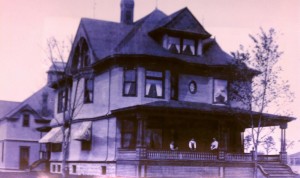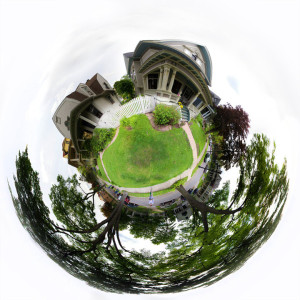
Welcome to the
Healy Project
Join us on Facebook
Send us an Email
Revoltin’ Developments II: Healy Houses in the Wedge
In 1980 when then-Wedge-resident Anders Christensen examined the building permits for all the houses in Lowry Hill East, he discovered that a master builder named Theron Potter Healy had built 30 of them. Further research revealed that during his career (1886-1906), Healy had built over 120 houses and commercial buildings in Minneapolis.
In 1993 Healy’s most celebrated creations, the Queen Annes of the 3100 block of Second and Third Avenue South, received national historic designation as the Healy Block Historic District. In 1977 Healy’s Bennett-McBride House had been listed on the National Register of Historic Places as a superb example of the Queen Anne architectural style.
During the first Wedge Zoning and Planning Committee meeting on the Lander Group’s redevelopment plans for 24th and Colfax, architect Pete Keeley said he had contacted the City, and they had said the two houses slated for demolition had “no historical significance.” At the second meeting, another man supporting owner Michael Crow alleged that the Minnesota Historical Society, too, had said that the Healy house at 2320 was not historically important. I’m sure that both claims are true: Neither the City nor M.H.S. have anything on record about either house.
None of Healy’s Wedge houses have received historic designation, but that does not mean that they are not historic or architecturally significant. Many historic buildings have not received official historic designation (through the Historic Preservation Commission or the National Trust, for example), but that in itself does not speak to their importance.
Consider, for example, the Wedge’s own “Healy Block”, the 2400 block of Bryant Avenue South. Eight (probably nine) houses on this block are Healy’s: 2401, -05, -09,(-10),-20, -24, -28, -36, and -39, ranging in style from Queen Anne to Colonial Revival.
 |
| 2439 Bryant, Colonial Revival, 1905 |
 |
|||||||||||||
| 2409 Bryant, Queen Anne, 1895 |
On Bryant Avenue north of 24th Street (in the R-6 zone) are four other Healy houses; three of these are currently rooming houses. None of the houses on the 2400 block are rooming houses, although half of them were at one time. Former residents have told stories of tenants riding motorcycles up staircases, drunken brawls, drug deals, even murders taking place in these houses. Yet today, with the investments in time and money of their owner-occupants, they have become beautiful and valuable homes.
2320 Colfax, the Healy house slated for demolition, represents a pivotal point in Healy’s career. It is one of only two houses built by Healy in 1893. The other 1893 Healy house, 821 Douglas Avenue, was wrecked in 1981 by developer Paul Klodt. 1893 is a significant year in the history of architecture, the year of the Chicago World’s Fair. In this year the Queen Anne style began to fall out of fashion, replaced by the Colonial Revival style, made popular by the Fair’s “White City”. 2320 is Healy’s first Colonial Revival house, a significant part of his architectural legacy.
An old photo of 2320 reveals the original appearance of the house, with a large barn in back, and open field to the north:
 |
| The Orth House, 2320 Colfax, as it appeared when new. |
 |
| The house today. The porch has been enclosed, but the original roof line, profile, and fenestration remain. |
Obviously, some people don’t care diddlysquat about history or architecture, and this blog is not addressed to them. I have learned a very important lesson from my service on the Minneapolis Heritage Preservation Commission and the Advocacy Committee of the Preservation Alliance of Minnesota: Governments and institutions are not concerned with saving buildings. Communities must define and speak out on what’s important to the community–and work to preserve it.
The 2004 LHENA Zoning Task Force clearly articulated what is important to Wedge residents, that is, ensuring the livability of the neighborhood by preserving the current mix of houses and multiple-unit buildings. Michael Lander has already redeveloped the southern part of the Wedge along the Greenway with high density apartment buildings and condominiums. This redevelopment makes sense in that it replaced a defunct industrial area. But the apex of the Wedge is a different story. Development supporters have made much of the idea of saving the neighborhood “core”, while keeping the “fringe” high density. Truth to say, the apex is such a small area that most of it can be considered “fringe” of the greater neighborhood, the current view from City Hall. The point is moot: R-6 allows high density throughout, so-called “core” included.
Last month a first in a series of meetings was convened by the City to look into the feasibility of establishing “conservation districts” in Minneapolis. Such districts would offer more protections than the zoning code, but fewer than those of historic districts, such as the Healy Block. A conservation district would certainly be a big step forward in saving the houses in the apex of the Wedge, but the idea is only at the beginning of a long planning process, with no guarantee it will be adopted.
 |
| “360 Degrees of Wedge Healys”–Photo art by Richard Mueller |
In conclusion, I want to stress that if you want to save 2320 Colfax and preserve the other houses in the Wedge, don’t expect City Hall or an historical society to do it for you. Property rights are held sacrosanct in this country, and owners can wreck properties on the National Register if they so choose. Case in point–the developer in Arizona who wants to demolish a house designed by Frank Lloyd Wright. Despite a firestorm of outrage and temporary stay of demolition from the City of Phoenix, the developer is still determined to take it down.
Former Zoning Task Force member Sue Bode said at the first LHENA hearing about the 2316-2320 plan, “Taking down a Healy house is like destroying one by Frank Lloyd Wright.” If you care about Healy’s legacy, if you care about the old houses of the Wedge, speak out.
 |
|
| CAN PREVENT DEMOLITIONS! |
–T.B.